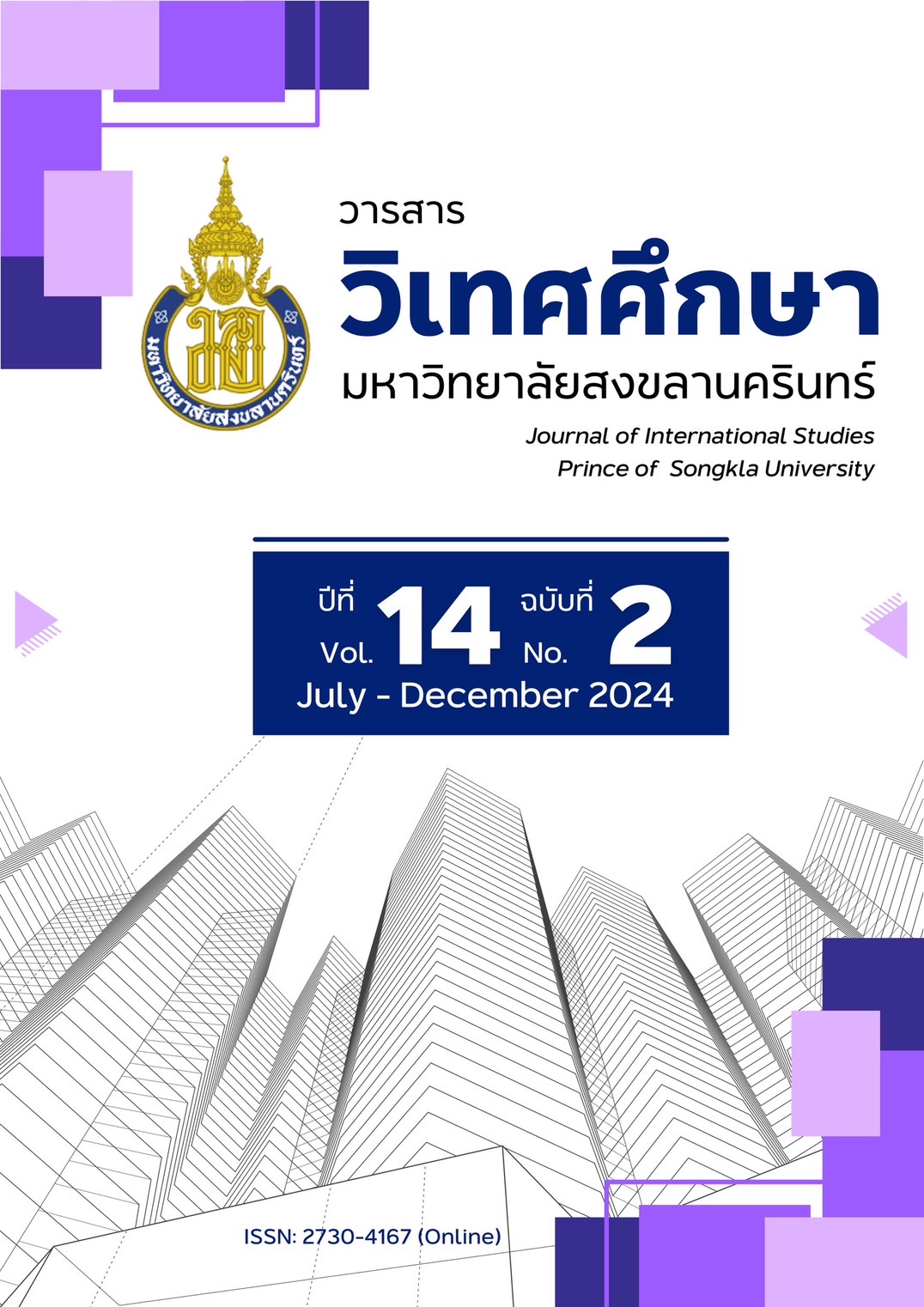การศึกษาเปรียบเทียบลิลิตพระลอและม่านประเพณี: สัญลักษณ์และภาพแทนของคตินิยม ในมุมมองสังคมวัฒนธรรมไทยและจีน
Main Article Content
บทคัดย่อ
การศึกษานี้มีวัตถุประสงค์เพื่อวิเคราะห์สัญลักษณ์และภาพแทนของคตินิยมและระบบความเชื่อในสังคมไทยและจีนและความเหมือนและความแตกต่างของมุมมองทางความคิด อิทธิพลทางศาสนาและบริบททางสังคมวัฒนธรรมในลิลิตพระลอและม่านประเพณี การศึกษานี้ใช้วิธีการเชิงคุณภาพ โดยการรวบรวมข้อมูลทุติยภูมิและงานวิจัยที่เกี่ยวข้องและคำอธิบายเชิงวิเคราะห์ของบริบททางสังคมวัฒนธรรมไทยและจีน โดยใช้วิธีการการวิเคราะห์เชิงเปรียบเทียบและการวิเคราะห์เนื้อหาเพื่อวิเคราะห์กลุ่มตัวอย่างที่เลือก ลิลิตพระลอเป็นภาพแทนของความเชื่อเรื่องภูติผีวิญญาณหรือสิ่งลี้ลับเหนือธรรมชาติที่ผสมผสานกับพระพุทธศาสนาและศาสนาพราหมณ์-ฮินดูที่หล่อหลอมเอกลักษณ์ของวัฒนธรรมไทย ม่านประเพณีเป็นนิทานพื้นบ้านของจีนที่สะท้อนให้เห็นองค์ประกอบของลัทธิขงจื๊อและลัทธิเต๋าอันเป็นแก่นแท้ของสังคมจีนดั้งเดิม นิทานทั้งสองเรื่องมีบทบาทสำคัญในการสะท้อนคตินิยม ระบบความเชื่อและสร้างคุณค่าทางวัฒนธรรมในประเทศไทยและประเทศจีน การวิเคราะห์ความเหมือนและความแตกต่าง พบว่า ทั้งสองวัฒนธรรมต่างปลูกฝังแนวคิดเรื่องการเคารพ ผู้อาวุโสและเชื่อฟังพ่อแม่ อย่างไรก็ตาม อิทธิพลทางค่านิยมความคิดและศาสนากลับมีความแตกต่างเนื่องจากบริบททางสังคมและวัฒนธรรมหลายประการ ปรัชญาจีนจะให้ความสำคัญกับหลักการในการอยู่ร่วมกันในสังคมอย่างสมานฉันท์ แต่คนไทยเชื่อในเหตุและผลของการกระทำ นอกจากนี้ ลิลิตพระลอและม่านประเพณียังแสดงให้เห็นถึงความไม่เท่าเทียมกันและนัยของลำดับชั้นทางเพศภายใต้ระบบอุปถัมภ์และสังคมปิตาธิปไตยอีกด้วย
Article Details

This work is licensed under a Creative Commons Attribution-NonCommercial-NoDerivatives 4.0 International License.
ข้อความและความคิดเห็นที่แสดงในบทความ เป็นแนวคิดของผู้เขียน มิใช่ความรับผิดชอบของกองบรรณาธิการ และคณะผู้จัดทำแต่อย่างใด
บทความ ข้อมูล เนื้อหา รูปภาพ ฯลฯ ที่ได้รับการตีพิมพ์ในวารสารวิเทศศึกษา ถือเป็นลิขสิทธิ์ของวารสารวิเทศศึกษา หากบุคคลหรือหน่วยงานใดต้องการนำทั้งหมดหรือส่วนหนึ่งส่วนใดไปเผยแพร่ต่อหรือเพื่อกระทำการใด ๆ จะต้องได้รับอนุญาตเป็นลายลักษณ์อักษรจากวารสารวิเทศศึกษา ก่อนเท่านั้น
References
Bascom, W. (1965). Four Functions of Folklore. In A. Dundes (Ed.), The Study of Folklore (pp. 279–298). Prentice-Hall.
Bickner, R. J. (2020). The Story of King Lo. Silkworm Books. (ISBN 978-6-16-215160-6)
Carter, A. (2021). Thailand’s fusion of religious beliefs: Buddhism, Animism and Brahmanism. Thaiger. https://thethaiger.com/news/national/thailands-fusion-of-religious-beliefs-buddhism-animism-and-brahmanism
China Net(中国网) (2005). Overview of Chinese History(中国历史概况). The Central People's Government of the People's Republic of China (中国人民共和国中央人民政府). https://www.gov.cn/test/2005-05/24/content_436.htm.
Dundes, A. (2007). MEANING OF FOLKLORE: The Analytical Essays of Alan Dundes (S. J. Bronner, Ed.). Utah State University Press.
Foy, G. (2019). Chinese Religions and Philosophies. Asia Society. https://asiasociety.org/chinese-religions-and philosophies.
Greetz, C. (1973). The Interpretation of Cultures (pp. 87–125, 193–233). Basic Books.
Guan, J. (关键英) (2019). 中国传统文化的独特气质 (The unique temperament of traditional Chinese culture). QSTHEORY. http://www.qstheory.cn/dukan/hqwg/2019-11/11/c_1125217538.htm
Hall, S. (1997). The Work of Representation. In Representation: Cultural Representations and Signifying Practices (pp. 13–74). SAGE Publications Ltd.
Hall, S. (2013). The Work of Representation. Retrieved from https://www.sagepub.com/sites/default/files/upm-binaries/ 55352 _Hall_ch_1.pdf
Hays, J. (2014). THAI SOCIETY: HIERARCHY, STATUS, CLASS, HI-SO CULTURE AND THE PATRON-CLIENT SYSTEM | Facts and Details. Factsanddetails.com. https://factsanddetails.com/southeast-asia/Thailand/sub5_8c/entry-3228.html.
Idema, W. L. (2010). The Legend of Liang Shanbo and Zhu Yingtai: Four Versions with Related Texts. Hackett Publishing.
Lévi-Strauss, C. (1955). The Structural Study of Myth. The Journal of American Folklore, 68(270), 428–444.
Malinowski, B., & Redfield, R. (1954). Magic, science and religion: and other essays. Doubleday.
Mark, J. J. (2020). Ancient Chinese Philosophy. World History Encyclopedia. https://www.worldhistory.org /Chinese_Philosophy/
McGee, R. J., & Warms, R. (2013). Symbolic and Interpretive Anthropology. SAGE Publications, Inc.
Rosser, S. V. (1992). Biology & Feminism: A Dynamic Interaction. Macmillan Reference USA.
Ruengruglikit, C. (2002). Reading Lilit Phra Law: Analysis and interpretation (อ่านลิลิตพระลอ ฉบับวิเคราห์และถอดความ). Chulalongkorn University Press.
Ruengruglikit, C. (2009). The Significance of Salahoen and Kaikaeo in Lilit Phra Lo. MANUSYA, 12(1), 1–10. https://doi.org/10.1163/26659077-01201001
Sathirakoset (Phraya Anumanratchathon) (1954). The tradition of Thai marriage (ประเพณีเรื่องแต่งงานบ่าวสาวของไทย) Rungrueang Tham.
Scroope, C. (2016). Thai Culture - Religion. Cultural Atlas. https://culturalatlas.sbs.com.au/thai-culture/thai-culture-religion.
Shirayama, Y., Phompida, S., & Kuroiwa, C. (2006). Modern medicine and indigenous health beliefs: malaria control alongside “Sadsana-phee” (animist belief system) in Lao PDR. Southeast Asian Journal of Tropical Medicine and Public Health, 37(4), 622–629.
Stefon, M. (2019). Chinese philosophy. Encyclopedia Britannica. https://www.britannica.com/topic/Chinese-philosophy.
Tarling, N. (1992). The Cambridge History of Southeast Asia: Volume 1, From Early Times to C.1800. Cambridge University Press.
Tourism Authority of Thailand. (2020). History & Geography & Geology. Tourism Authority of Thailand. https://www.tourismthailand.org/Articles/plan-your-trip-history-and-geography-geology.
Turner, V. (1967). The Forest of Symbols: Aspects of Ndembu Ritual (pp. 93–111). Cornell University Press.
Wanthana, S. (2019). Political Lessons from Lilit Phra Lor. Journal of Thai Studies, 1(6), 1–49.
Yarapirom, P. S., & Damrongpong, N. (2023). The Representation of Gender Definition through Ancient Chinese Folktales: Symbols of
Femininity Ideology, Negotiation, and Similarity of Female Status as Currently Era. Book of Proceedings of the 7th TICC International
Conference 2023 Titled Toward Sustainable Development Goals: Digital Transformation and Beyond, 444–461.
Yang, G. (杨国荣) (2015). 《庄子·齐物论》释义. 子夜星网站. http://www.ziyexing.com/files5/guwen/ guwen-30.htm.

